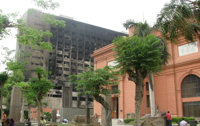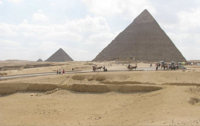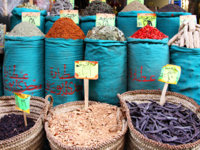Insider's travel guide to post-revolution Cairo
The Arab Spring saw demonstrators take to the streets of Cairo. But Ruth Styles, returning to a city still buzzing from the downfall of a dictator, found that the uprising has made visiting the Egyptian capital a surprisingly relaxed affair.
A woman in a brightly patterned scarf weaves through crooked lines of cars, her voice drowned out by a cacophony of excitable Arabic, gunning engines and endlessly tooting horns. On the corner, a white-shirted Egyptian policeman frantically waves his fluorescent baton and tries to stem the flood of traffic with shrill blasts from his whistle. But for the battered taxis, the balmy heat and the ever-present dust, it could almost be the Place du Concorde at rush hour. But it isn’t. This is Tahrir Square, one of Cairo’s busiest thoroughfares and the centre of a revolution watched on the world's television screens, ending in the ousting of Egyptian president, Hosni Mubarak.
A few months on and the policemen and street traders are busy as post-revolutionary Egypt gets back to work. The Tahrir Square branch of Hardees in central Cairo has recovered from being damaged during the protests and is selling cheap burgers again. The barricades are gone and the people are out in force: laughing, talking and sipping sugar cane juice bought on the roadside. But look closer and evidence of the demonstrations can still be seen. Looming over the Egyptian Museum, to the rear of the emblematic Tahrir Square, is the blackened shell of the National Democratic Party’s former headquarters.
 Cairo Museum and National Democratic Party building
Cairo Museum and National Democratic Party buildingRuth Styles
Close to the entrance of the Cairo museum, a dozen khaki-clad soldiers are leaning against the wall, smoking casually with their guns held at a sleepy angle. Hawkers intent on making a quick buck are doing a roaring trade in revolutionary memorabilia. Slogan t-shirts, cups emblazoned with ‘25th January’ (the day the demonstrations began) and piles of Egyptian flags are being haggled over. Patriotic graffiti is plastered on walls while the trees lining the route from the Kasr-el-Nil Bridge to the square have acquired black, red and white rings – the colours of the Egyptian flag. Even cosmopolitan quarters like Zamalek are getting in on the act, with revolutionary slogans emblazoned on a white brick wall opposite the Libyan embassy.
But for the economy, however, the Arab Spring has brought new problems. Already reeling from a spate of shark attacks in Sharm-El-Sheikh last December, January’s uprising has seen tourism in the capital flatline, while bookings in the Red Sea are also down on this time last year. But for travellers willing to brave post-revolution Cairo, there are some definite benefits. Prices for hotel rooms are down, with chic city hotels offering discounted rates and special offers galore. Most restaurants are only too happy to see you; their need for custom resulting in even better service than usual – quite the achievement in a city as friendly as Cairo. Unfortunately, the paucity of other tourists doesn’t always work in your favour, as a visit to the Pyramids illustrated.
 The iconic Pyramids are not currently busy with tourists
The iconic Pyramids are not currently busy with touristsRuth Styles
Rising out of the desert on the edge of the Cairo suburb of Giza, the Pyramids looked busy at first but close up, it was obvious that most people there were locals, many of whom were underemployed guides. Finding a guide has never been a problem at the Pyramids – fending them off has always been more of a priority – but this time, it was truly ridiculous. Still on the main road, we were ambushed by guides who forced their way into our taxi in an attempt to persuade us to visit the monument with them. Having kicked them out, a cloud of others surrounded us when we finally made it to the buildings themselves.
While no one had anything good to say about Mubarak, one guide, Ramy, admitted that things have been tough since winter. Talking nineteen-to-the-dozen, he ushered us solicitously round the honey-gold structures offering to take photos and promising good rates for camel rides. He even helped us shake off the hordes of souvenir salesmen, who buzzed around trying to sell Pyramid paperweights, cheap necklaces and old-fashioned postcards. But there are better places to shop than the Pyramids and at Khan-El-Khalili, the lack of tourists was having a different effect entirely.
 Shopping for spices in Cairo
Shopping for spices in CairoIstockphoto/Thinkstock
At Cairo’s most famous bazaar, the goods were there but few were around to buy them. We spotted nine tourists – a paltry number in comparison to the coach loads who normally throng the twisty streets – but plenty of locals. The emptiness made wandering around the souk a much better experience than usual, with plenty of time to stop and watch the business and the banter. We saw one man making sandwiches with bits of meat expertly flayed from a boiled goat’s head, chased by a pack of alley cats fighting over the scraps. He didn’t seem to mind and even encouraged them by throwing extra bits. Other traders and shoppers sat quietly on benches, enjoying the peaceful afternoon sunshine and sipping sugary mint tea. We had ours with Mohammed, owner of a tiny shop at the end of the bazaar. Batting away offers of payment, he sat and chatted with us before showing us his shop, stocked with bracelets made from gold coins and star shaped brass lamps. Everyone wanted to stop and chat, not just in Khan-el-Khalili, but all over town. From the smiling baker at a little cake shop on the corner of Roushdy Street to the chain-smoking taxi drivers, everyone had their own revolutionary tale to tell.
Back in Zamalek, the dance floor at local hotspot, Cairo Jazz, was packed with a throng of party-goers untroubled by the curfew, which is implemented loosely from two to five am. No-one seemed to mind that demonstrations had flared up again the previous Friday, this time with a religious tone and several deaths. But they weren't alone. At houseboat-cum-club, Stiletto, salsa night was in full swing with dancers more worried about getting their steps right than getting home safely. But then, for a city that's supposedly on lockdown, and with tourists staying away, Cairo feels remarkably confident. And with Pyramids, bazaars and nightlife all in fine fettle, short of an Iran-style government taking power, a renaissance in the tourism sector can't be too far off. In fact, now might just be the perfect time to go. After all, the crowds won't be gone for long.
Travel essentials
Buy: A revolutionary T-shirt for around E£20. Haggle.
Check: Travel advice before you go.
Stay: The Kempinski Nile Hotel has rooms overlooking the river Nile in a central location just five minutes walk from Tahrir Square and the National Museum. A short taxi ride away is the urbane Zamalek quarter, packed with cafés specialising the ubiquitous kharkade and lemon-mint juice, plus shops selling everything from high quality cotton to locally made natural toiletries. Each room features neutral décor, a private balcony and a comfortable double bed, along with the use of a personal butler. It doesn't feel particularly Egyptian but it's central and comfortable. Breakfasts are substantial and there's an excellent jazz bar on the 10th floor, as well as a rooftop terrace with panoramic views of the city. Rates start at £150 per night. www.kempinski.com.
Getting there: Egyptair operates daily flights to and from a wide range of European capitals, including London, Berlin and Copenhagen, from its Cairo hub. Flights from London to Cairo with Egyptair start at £380 return. www.egyptair.com.
Do you have any Feedback about this page?
© 2025 Columbus Travel Media Ltd. All rights reserved. No part of this site may be reproduced without our written permission, click here for information on Columbus Content Solutions.









 You know where
You know where